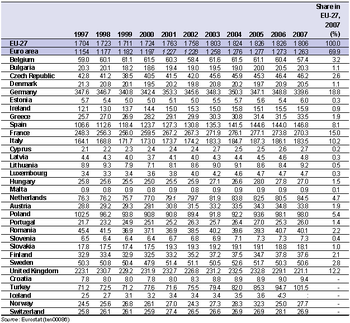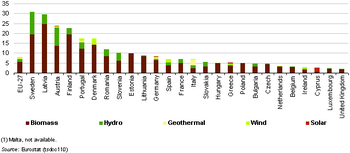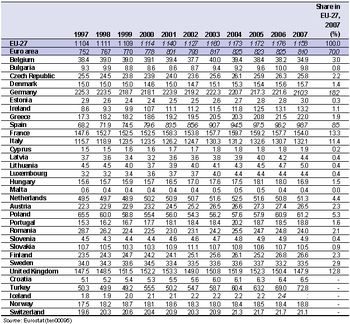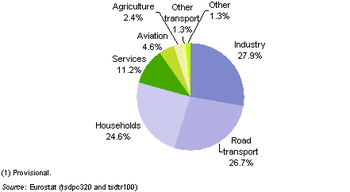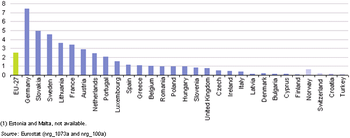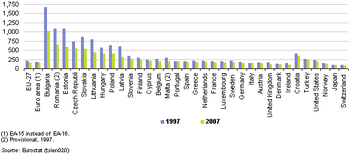Archive:Consumption of energy
- Data from September 2009, most recent data: Further Eurostat information, Main tables and Database.
This article explains how consumption of energy in the European Union has evolved, highlighting the shift from fossil fuels to renewable energy sources, such as solar energy, wind power, and biofuels. It also looks at the evolution of energy use in the transport sector.
In tandem with supply-side policies, the EU has launched a number of initiatives which aim to reduce energy demand and attempt to decouple it from economic growth. Several instruments and implementing measures exist in this field, including the promotion of co-generation, the energy performance of buildings (whether private or public buildings), and energy labelling of domestic appliances.
The EU has pledged to cut its energy consumption by 20 % by 2020.
Main statistical findings
Consumption
Gross inland energy consumption within the EU-27 in 2007 was 1 806 million tonnes of oil equivalent, which marked a decline in consumption to a level not seen since 2003. The gross inland consumption of each Member State depends, to a large degree, on the structure of its energy system and the availability of natural resources for primary energy production; this is true not only for conventional fuels and nuclear power, but also for renewable energy sources. For example, although small in absolute levels, the use of solar power is relatively high in Mediterranean countries such as Cyprus, while the use of biomass is of increasing importance in some Member States with considerable forest areas, for example, Latvia, Finland and Sweden. In a similar vein, hydropower is particularly important in mountainous countries with ample water supplies, such as Austria or Sweden.
Over the period 1997 to 2007 there was a gradual decline in the gross inland consumption of crude oil and petroleum products and solid fuels, while increasing amounts of natural gas and renewable energy sources were consumed. The combined share of crude oil, petroleum products and solid fuels fell from 58.8 % of total consumption to 54.1 %, reflecting changes in the EU-27’s energy mix and a move away from the most polluting fossil fuels. Renewable energy sources accounted for 7.8 % of EU-27 gross inland consumption in 2007; however, their relative importance rose to almost one third of the total in Sweden and Latvia, and was close to one quarter of the total in Austria and Finland.
Final energy consumption in the EU-27, i.e., excluding energy used by power producers, was equivalent to just under two thirds (64.1 %) of gross inland consumption, at 1 158 million toe in 2007.
The lowest levels of energy intensity – a measure of an economy’s energy efficiency – were recorded for Denmark and Ireland in 2007, while the most energy-intensive Member States were Bulgaria and Romania. It should be noted that the economic structure of an economy plays an important role in determining energy intensity, as post-industrial economies with large service sectors will, a priori, have considerably lower energy use than economies characterized by heavy, traditional industries, such as steel-making. Between 1997 and 2007, substantial energy savings were made in the Baltic economies of Estonia, Latvia and Lithuania, as the amount of energy required to produce a unit of economic output (as measured by GDP) was almost halved; the energy intensity of the Bulgarian and Romanian economies also fell at a rapid pace, by almost 40 %.
End-users
An analysis of the final end use of energy shows three dominant categories: as industry, road transport and households each accounted for around one quarter of the EU-27’s final energy consumption in 2007; adding the figures for the different transport modes together, their total energy consumption amounted to 377.2 million toe in 2007, or approximately one third of the total.
There were, however, considerable differences in the evolution of energy consumption across transport modes in the EU-27, with the most rapid growth for aviation (42.3 % between 1997 and 2007) and a steady upward trend for road transport (17.0 %), while the energy consumption of rail was relatively unchanged (-2.9 %). The largest increase, in absolute terms, was however recorded for road transport, where EU-27 energy consumption rose by 44.8 million toe between 1997 and 2007, compared with a 15.9 million toe increase for aviation. These changes in energy consumption reflect the popularity of each transport mode, but can also be influenced by technological changes, especially when these relate to fuel-efficiency gains.
In 2007, a minimum target was set for renewable energy sources (such as biofuels), requiring that they should account for at least 10 % of the petrol and diesel used within the road transport sector by 2020. Data for 2007 show that biofuels made the biggest contribution to fuel consumption in Germany (7.4 %) and Slovakia (4.9 %), while the EU-27 average was 2.5 %.
Data sources and availability
Gross inland energy consumption represents the quantity of energy necessary to satisfy inland consumption of the geographical entity under consideration. It may be defined as primary production plus imports, recovered products and stock changes, less exports and fuel supply to maritime bunkers (for seagoing ships of all flags). It describes the total energy needs of a country (or entity such as the EU), covering: consumption by the energy sector itself; distribution and transformation losses; final energy consumption by end users; and statistical differences
Final energy consumption includes the consumption by all users except the energy sector itself (whether for deliveries, for transformation, and/or its own use), and includes, for example, energy consumption by agriculture, industry, services and households, as well as energy consumption for transport. It should be noted that the fuel quantities transformed in the electrical power stations of industrial auto-producers and the quantities of coke transformed into blast-furnace gas are not part of overall industrial consumption but of the transformation sector. Final energy consumption in transport covers the consumption in all types of transportation, i.e., rail, road, air transport and inland navigation. Final energy consumption in households, services, etc. covers quantities consumed by private households, commerce, public administration, services, agriculture and fisheries.
Energy intensity is measured as the ratio between gross inland consumption of energy and Gross domestic product for a given calendar year. It measures the energy consumption of an economy and its overall energy efficiency. The ratio is expressed as kgoe (kilogram of oil equivalent) per EUR 1 000, and to facilitate analysis over time these calculations are based on GDP at constant prices (currently 1995 prices). If an economy becomes more efficient in its use of energy and its GDP remains constant, then the ratio for this indicator should fall. The economic structure of an economy plays an important role in determining energy intensity, as post-industrial economies with large service sectors will, a priori, display relatively low intensity rates, while developing economies may have a considerable proportion of their economic activity within industrial sectors, thus leading to higher intensity.
Context
As well as supply-side policies, there is a growing trend for policy initiatives to focus on improving energy efficiency in an attempt to reduce energy demand and decouple it from economic growth. This was given further impetus by the integrated energy and climate change strategy that committed the EU to cut energy consumption by 20 % in relation to projected 2020 levels; by doing so, the EU hopes to cut greenhouse gas emissions by almost 800 million tonnes a year, while improving sustainability and security of supply.
To achieve these goals, the EU seeks to engage public opinion, decision-makers and market operators, while setting minimum energy efficiency standards and rules on labelling for products, services and infrastructure, in order to encourage significant reductions in consumption – for example, through the promotion of co-generation, improving the energy performance of buildings, or improving the information given to consumers with respect to the energy consumption of domestic appliances.
Daily life is becoming increasingly dependent on energy-consuming devices. Without compromising standards of living, there are a range of actions that could be employed to reduce energy consumption across many European households. Aside from making efficiency savings, these measures could also cut average fuel bills, for example, by: turning the thermostat down by one degree; using thermostatic radiator valves; not leaving televisions, videos, music systems or DVD players on stand-by; defrosting fridges and freezers regularly; turning off lights when leaving rooms; using low-energy light bulbs; insulating hot-water tanks and heating pipes; or using loft insulation and cavity wall insulation.
The transport sector is the fastest growing consumer of energy and producer of greenhouse gases, even if advances in transport technology and fuel have resulted in marked decreases in emissions of certain pollutants. There are many factors that impact on energy use within the transport sector, for example, overall economic growth, the efficiency of individual transport modes, the take-up of alternative fuels, and lifestyle choices. The globalised nature of the economy has fuelled demand for international freight movements (principally by ship), while within the Single Market there has been a considerable expansion in the use of road freight transport (see Transport energy consumption and emissions). This growth in the demand for energy from the transport sector is not confined to business, as it has been accompanied by an expansion in personal travel. The development of low-cost airlines, an increase in motorisation rates (the average number of motor vehicles per inhabitant), a trend for living in suburban areas, or the expansion of tourism (more frequent breaks, and more long-haul destinations) are among some of the factors that have contributed to an increase in the demand for energy as a result of personal travel.
In October 2006 the European Commission adopted an action plan for energy efficiency COM(2006) 545 which was supported by the Council of the European Union in November 2006. The plan proposes to cut energy consumption by 20 % by 2020 and in so doing simultaneously address the issues of import dependency, energy-related emissions, and energy costs.
Providing transport for goods and passengers, whether for own-use or for hire and reward, consumes significant amounts of energy. There are many factors that have an impact on energy use and emissions in transport, for example, overall economic growth, the efficiency of individual transport modes, the combination of different transport modes, alternative fuels, and lifestyle choices.
In 2001, the European Commission adopted a policy to promote biofuels for transport, and set a number of targets. In March 2007 the Council supported plans to increase the level of renewables (such as biofuels) in transport fuel to 10 % by 2020.
Further Eurostat information
Publications
- Panorama of energy: energy statistics to support EU policies and solutions
- Energy – yearly statistics
- Energy balance sheets
Main tables
- Energy, see:
- Energy Statistics - quantities (t_nrg_quant)
- Share of renewables in gross inland energy consumption (tsdcc110)
- Gross inland consumption of primary energy (ten00086)
- Gross inland energy consumption, by fuel (tsdcc320)
- Consumption of electricity by industry, transport activities and households/services (ten00094)
- Final energy consumption (ten00095)
- Final energy consumption, by sector (tsdpc320)
- Final energy consumption of petroleum products (ten00096)
- Final energy consumption of electricity (ten00097)
- Final energy consumption of natural gas (ten00098)
- Final energy consumption by industry (ten00099)
- Final energy consumption by transport (ten00100)
- Energy consumption of transport, by mode (tsdtr100)
- Final energy consumption by households, trades, services, etc. (ten00101)
- Electricity consumption of households (tsdpc310)
- Energy dependency (tsdcc310)
- Combined heat and power generation (tsien030)
- Share of biofuels in fuel consumption of transport (tsdcc340)
Database
- Energy, see:
- Energy Statistics - quantities (nrg_quant)
- Energy Statistics - supply, transformation, consumption (nrg_10)
- Supply, transformation, consumption - all products - annual data (nrg_100a)
- Supply, transformation, consumption - solid fuels - annual data (nrg_101a)
- Supply, transformation, consumption - oil - annual data (nrg_102a)
- Supply, transformation, consumption - gas - annual data (nrg_103a)
- Supply, transformation, consumption - electricity - annual data (nrg_105a)
- Supply, transformation, consumption - heat - annual data (nrg_106a)
- Supply, transformation, consumption - renewables and wastes (total, solar heat, biomass, geothermal, wastes) - annual data (nrg_1071a)
- Supply, transformation, consumption - renewables (hydro, wind, photovoltaic) - annual data (nrg_1072a)
- Supply, transformation, consumption - renewables (biofuels) - annual data (nrg_1073a)
- Energy Statistics - supply, transformation, consumption (nrg_10)
External links
- European Commission - Energy - Energy policy for a competitive Europe
- European Commission - Mobility & Transport - European strategies
- International Energy Agency (IEA) - World Energy Outlook
- OECD - Energy - Climate Change, Energy and Transport
